Page 147 of 185
146 Navigation*
During route guidance
�Standard setting option:
The scales for full-screen and split-
screen map display are always
identical. Changing the scale
(
�page 133) on one map changes
the scale of the other.
�Manual option:
The scales can be different. Chang-
ing the scale on one map has no ef-
fect on the current scale of the
other map.
�Use or to select the desired op-
tion.
�Press .
Depending on the previous setting, the
Standard (identical scale) or Manual (indi-
vidual scale) option is activated.
�Finally, press the Back soft key or wait
for the screen to change.
i
The solid circle shows the current
setting.
Page 148 of 185
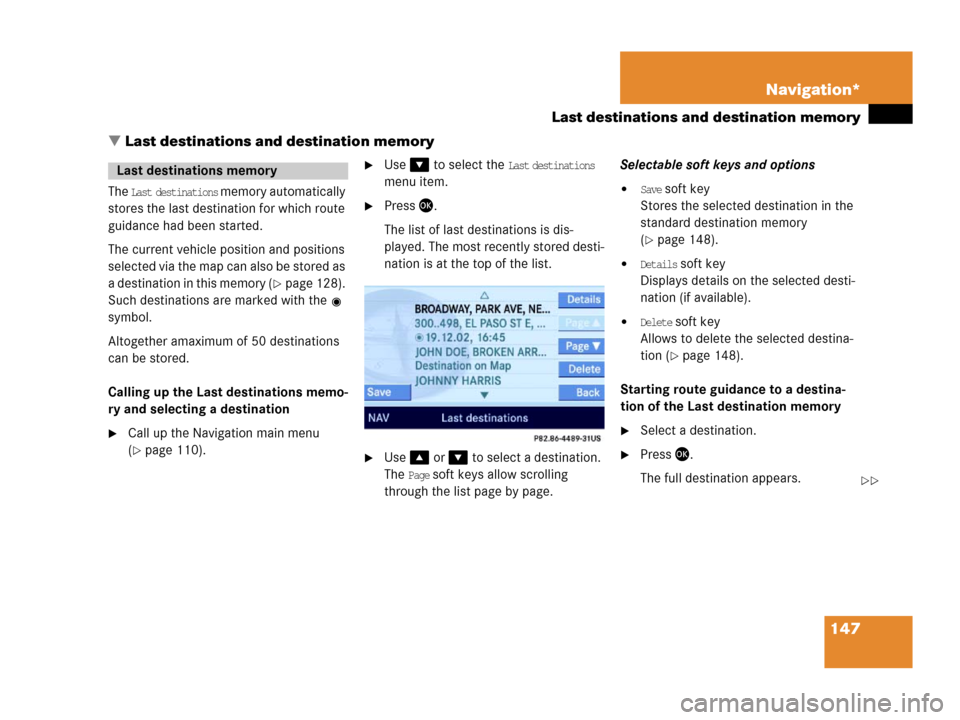
147 Navigation*
Last destinations and destination memory
� Last destinations and destination memory
The Last destinations memory automatically
stores the last destination for which route
guidance had been started.
The current vehicle position and positions
selected via the map can also be stored as
a destination in this memory (
�page 128).
Such destinations are marked with the
symbol.
Altogether amaximum of 50 destinations
can be stored.
Calling up the Last destinations memo-
ry and selecting a destination
�Call up the Navigation main menu
(
�page 110).
�Use to select the Last destinations
menu item.
�Press .
The list of last destinations is dis-
played. The most recently stored desti-
nation is at the top of the list.
�Use or to select a destination.
The
Page soft keys allow scrolling
through the list page by page.Selectable soft keys and options
�Save soft key
Stores the selected destination in the
standard destination memory
(
�page 148).
�Details soft key
Displays details on the selected desti-
nation (if available).
�Delete soft key
Allows to delete the selected destina-
tion (
�page 148).
Starting route guidance to a destina-
tion of the Last destination memory
�Select a destination.
�Press .
The full destination appears.
Last destinations memory
��
Page 149 of 185
148 Navigation*
Last destinations and destination memory
�Press if you want to start route
guidance, otherwise press the
Back soft
key.
Deleting a destination from the last
destinations memory
�Select a destination (�page 147)
�Press the Delete soft key.
You are prompted to confirm whether
or not the destination is to be deleted.
�Use to select the menu item Yes.
�Press .
The destination is deleted.
Calling up the destination memory and
selecting a destination
�Call up the Navigation main menu
(
�page 110).
�Use or to select the Destination
memory
menu item.
�Press .
The destination memory appears. This
is indicated by
Destination memory in the
status bar.
�Use, , , or to select the
desired entry.
Selectable soft keys and options
�Details soft key
Displays details on the selected desti-
nation (if available).
�Delete soft key
Allows to delete the selected destina-
tion (
�page 149).
Destination memory
Page 150 of 185
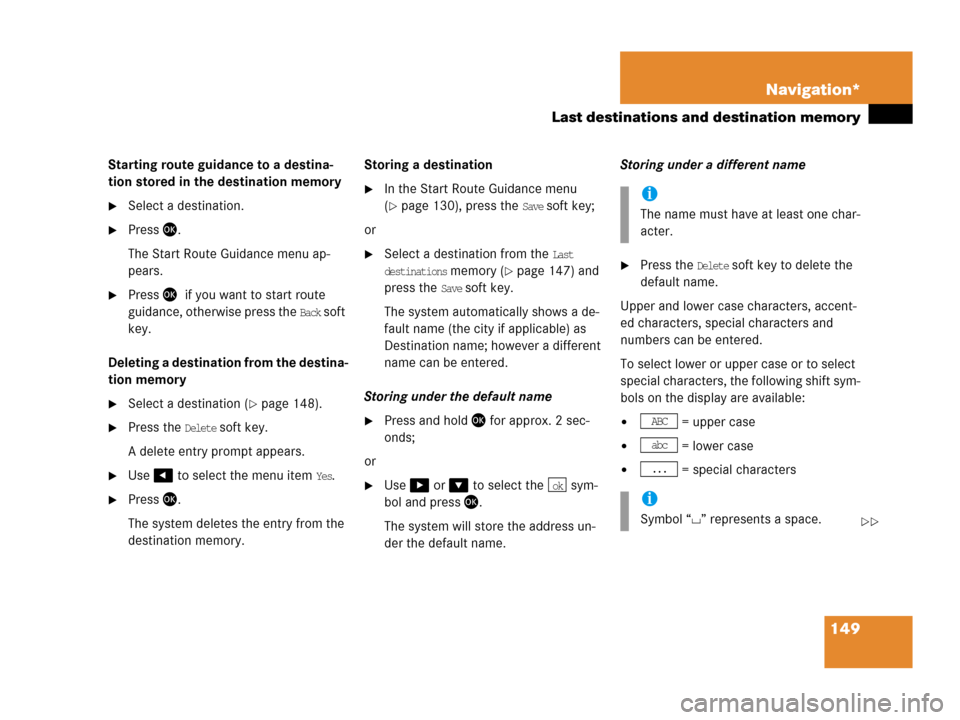
149 Navigation*
Last destinations and destination memory
Starting route guidance to a destina-
tion stored in the destination memory
�Select a destination.
�Press .
The Start Route Guidance menu ap-
pears.
�Press if you want to start route
guidance, otherwise press the
Back soft
key.
Deleting a destination from the destina-
tion memory
�Select a destination (�page 148).
�Press the Delete soft key.
A delete entry prompt appears.
�Use to select the menu item Yes.
�Press .
The system deletes the entry from the
destination memory.Storing a destination
�In the Start Route Guidance menu
(
�page 130), press the Save soft key;
or
�Select a destination from the Last
destinations memory (�page 147) and
press the
Save soft key.
The system automatically shows a de-
fault name (the city if applicable) as
Destination name; however a different
name can be entered.
Storing under the default name
�Press and hold for approx. 2 sec-
onds;
or
�Use or to select the sym-
bol and press .
The system will store the address un-
der the default name.Storing under a different name
�Press the Delete soft key to delete the
default name.
Upper and lower case characters, accent-
ed characters, special characters and
numbers can be entered.
To select lower or upper case or to select
special characters, the following shift sym-
bols on the display are available:
� = upper case
� = lower case
� = special characters
ok
i
The name must have at least one char-
acter.
i
Symbol “ ” represents a space.
ABC
abc
...
��
Page 153 of 185
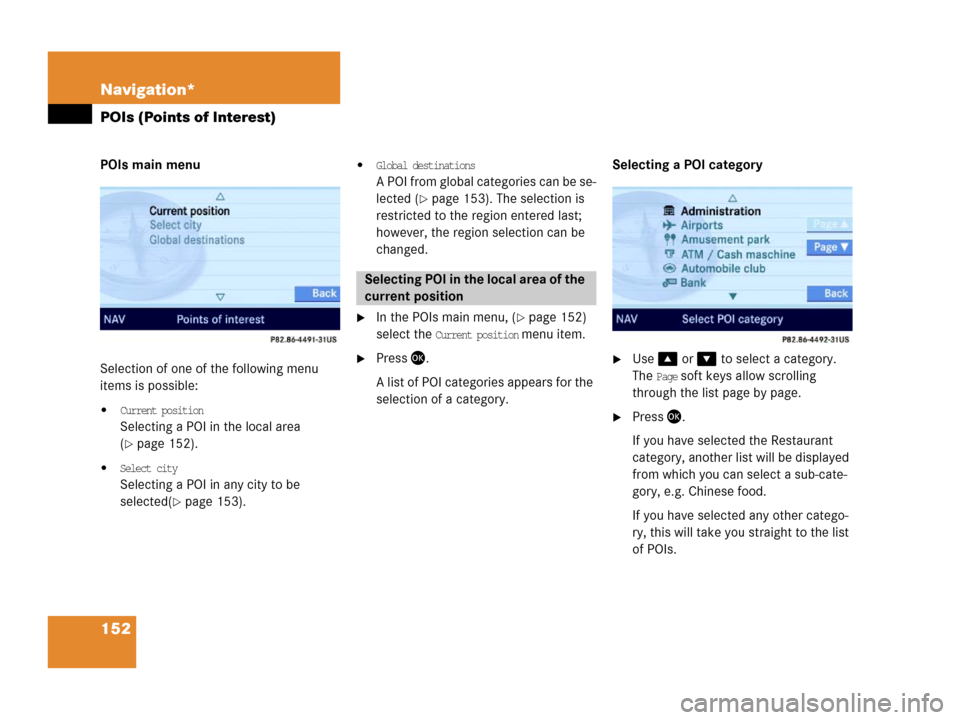
152 Navigation*
POIs (Points of Interest)
POIs main menu
Selection of one of the following menu
items is possible:
�Current position
Selecting a POI in the local area
(
�page 152).
�Select city
Selecting a POI in any city to be
selected(
�page 153).
�Global destinations
A POI from global categories can be se-
lected (
�page 153). The selection is
restricted to the region entered last;
however, the region selection can be
changed.
�In the POIs main menu, (�page 152)
select the
Current position menu item.
�Press .
A list of POI categories appears for the
selection of a category.Selecting a POI category �Use or to select a category.
The
Page soft keys allow scrolling
through the list page by page.
�Press .
If you have selected the Restaurant
category, another list will be displayed
from which you can select a sub-cate-
gory, e.g. Chinese food.
If you have selected any other catego-
ry, this will take you straight to the list
of POIs.
Selecting POI in the local area of the
current position
Page 156 of 185
155 Navigation*
POIs (Points of Interest)
The details disappear after approx.
3 seconds, or when pressing the
Details
soft key again.
�Press .
The Start Route Guidance menu ap-
pears.
�Press to start route guidance.
�Press
or
�In the Destination entry menu
(
�page 117), press the Map soft key.
The full-screen map appears. Symbols
indicate the POIs.
�If required, use, , , , ,
or to move the map.
�If the soft key displays are hidden,
press any soft key.
The soft key displays appear.
.
�Press the Symbol soft key.
A POI is selected and highlighted in col-
or. Its name appears in the status bar.
Selecting a POI using the map
i
The POI symbols to be displayed can be
selected (
�page 142).
Symbols are indicated only if the map
scale is set to 0.05 mi (50 m), 0.1 mi
(100 m), 0.2 mi (200 m), or 0.5 mi
(500 m).
To change the map scale (
�page 133).
��
Page 159 of 185
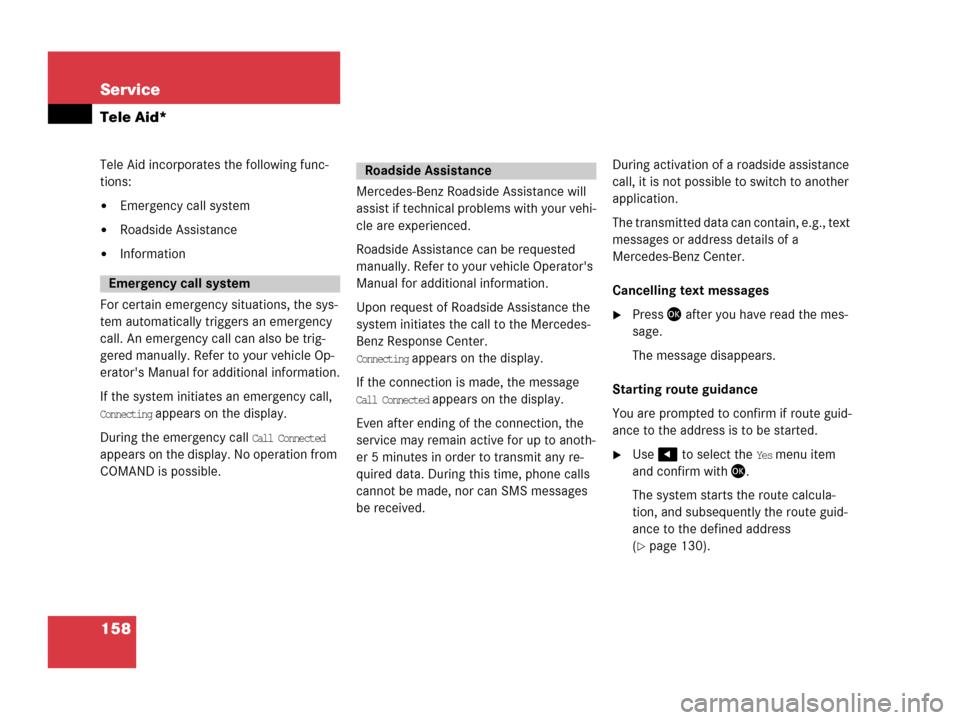
158 Service
Tele Aid*
Tele Aid incorporates the following func-
tions:
�Emergency call system
�Roadside Assistance
�Information
For certain emergency situations, the sys-
tem automatically triggers an emergency
call. An emergency call can also be trig-
gered manually. Refer to your vehicle Op-
erator's Manual for additional information.
If the system initiates an emergency call,
Connecting appears on the display.
During the emergency call
Call Connected
appears on the display. No operation from
COMAND is possible.Mercedes-Benz Roadside Assistance will
assist if technical problems with your vehi-
cle are experienced.
Roadside Assistance can be requested
manually. Refer to your vehicle Operator's
Manual for additional information.
Upon request of Roadside Assistance the
system initiates the call to the Mercedes-
Benz Response Center.
Connecting appears on the display.
If the connection is made, the message
Call Connected appears on the display.
Even after ending of the connection, the
service may remain active for up to anoth-
er 5 minutes in order to transmit any re-
quired data. During this time, phone calls
cannot be made, nor can SMS messages
be received.During activation of a roadside assistance
call, it is not possible to switch to another
application.
The transmitted data can contain, e.g., text
messages or address details of a
Mercedes-Benz Center.
Cancelling text messages
�Press after you have read the mes-
sage.
The message disappears.
Starting route guidance
You are prompted to confirm if route guid-
ance to the address is to be started.
�Use to select the Yes menu item
and confirm with .
The system starts the route calcula-
tion, and subsequently the route guid-
ance to the defined address
(
�page 130).
Emergency call system
Roadside Assistance
Page 160 of 185
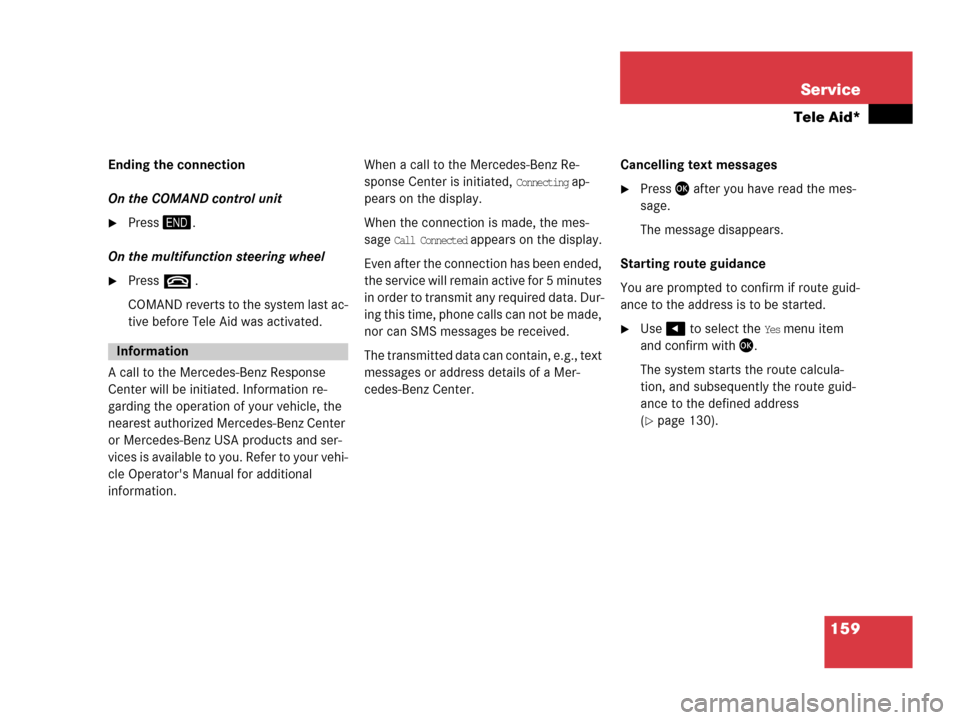
159 Service
Tele Aid*
Ending the connection
On the COMAND control unit
�Press.
On the multifunction steering wheel
�Presst .
COMAND reverts to the system last ac-
tive before Tele Aid was activated.
A call to the Mercedes-Benz Response
Center will be initiated. Information re-
garding the operation of your vehicle, the
nearest authorized Mercedes-Benz Center
or Mercedes-Benz USA products and ser-
vices is available to you. Refer to your vehi-
cle Operator's Manual for additional
information. When a call to the Mercedes-Benz Re-
sponse Center is initiated,
Connecting ap-
pears on the display.
When the connection is made, the mes-
sage
Call Connected appears on the display.
Even after the connection has been ended,
the service will remain active for 5 minutes
in order to transmit any required data. Dur-
ing this time, phone calls can not be made,
nor can SMS messages be received.
The transmitted data can contain, e.g., text
messages or address details of a Mer-
cedes-Benz Center.Cancelling text messages
�Press after you have read the mes-
sage.
The message disappears.
Starting route guidance
You are prompted to confirm if route guid-
ance to the address is to be started.
�Use to select the Yes menu item
and confirm with .
The system starts the route calcula-
tion, and subsequently the route guid-
ance to the defined address
(
�page 130).
Information